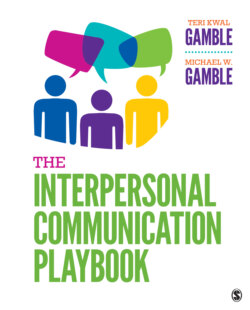Читать книгу The Interpersonal Communication Playbook - Teri Kwal Gamble - Страница 71
На сайте Литреса книга снята с продажи.
Self-Concept: Your Answer to Who You Are
ОглавлениеWhere does self-concept come from? While we are not born with a self-concept, over time we certainly develop one. The day a child first says “me,” the day there is recognition of the self as separate from one’s surroundings, life begins to change as a child strives to fit into the world as they see it. In short order, our concept of self—that relatively stable set of perceptions each of us attributes to ourselves—becomes our most important possession.
Beginning in childhood, the self-concept is a composite of everything we think and feel about ourselves. It is the perceived self—our self-identity—and it has two key components: self-image and self-esteem (see Table 2.1). Self-image is the mental picture you have of yourself—it sums up the kind of person you think you are. It is a composite of the roles you claim and the attitudes and beliefs you use to describe who and what you are to others, and your understanding of how others see you. Self-esteem is your self-evaluation—your estimation of your self-worth. In many ways, it is an indication of how much you like and value yourself, including your feelings, positive and negative, about your abilities, character, and feelings.
With this as background, it becomes apparent that self-concept affects communication presence and behavior, including what we think possible. As a result, it is important to use every opportunity to think carefully about self-concept.
Table 2.1
How you complete the sentences in the “Who Are You?” “Try This” box on page 38, and the categories into which your answers can be grouped, offers clues to your self-concept, including your self-image and self-esteem. For example, you might conceive of yourself in reference to your gender, religion or spirituality, race, nationality, physical attributes, roles, attitudes and emotions, mental abilities, or talents. The words you use to express your self-perceptions reveal what you think you are like. In many ways, your answers represent a construct that you have built to make sense of who you are. Remember, however, that the self-concept is not necessarily the same as the self.
Try This: Who Are You?
Begin the exploration of your self-concept by answering the following question: Who am I? How many answers can you give? Complete the sentence “I am ______” with a minimum of 10 different ways you view yourself.
As we hope you now realize, there are lots of ways to complete the sentences. For example, did you give information about personal traits, such as, “I am spiritual,” “I am attractive,” or “I am friendly”? Did you describe your social identity, such as “I am a Christian” or “I am Chinese”?
Taken together, your answers describe the elements or specific beliefs that constitute your self-concept. Look back at your answers. What do they reveal regarding how you define yourself? What roles do you see yourself playing? How do you describe yourself socially? As you completed the sentences, how did social comparisons, whether online or face-to-face, influence what you wrote? In what ways, if any, did past successes and failures as well as other people’s judgments play a part in determining your responses?
Analyze This: The Clown
As you read the following poem by Teri Gamble, consider these questions: What do you think is the significance of the clown’s omnipresent rainbow smile? Like the poem’s subject, do you ever “play” to people around you? Like the clown, do you ever wonder who you really are?
The rubber man in the spotlight
Propels himself
Beyond the reach
Of reality.
Midway between today and tomorrow
He pauses
Suspended in his reverie by the crowd.
The rubber man in the spotlight
Warmed by laughter
Finds a face
To play to.
Dancing upon an ever-turning spindle
He plays to another
And another, and another.
The rubber man in the spotlight
Sweeps up the dreams
That remind him
Of yesterday.
Then tumbling out of the ring
His face frozen in a rainbow smile
He wonders who he is.
